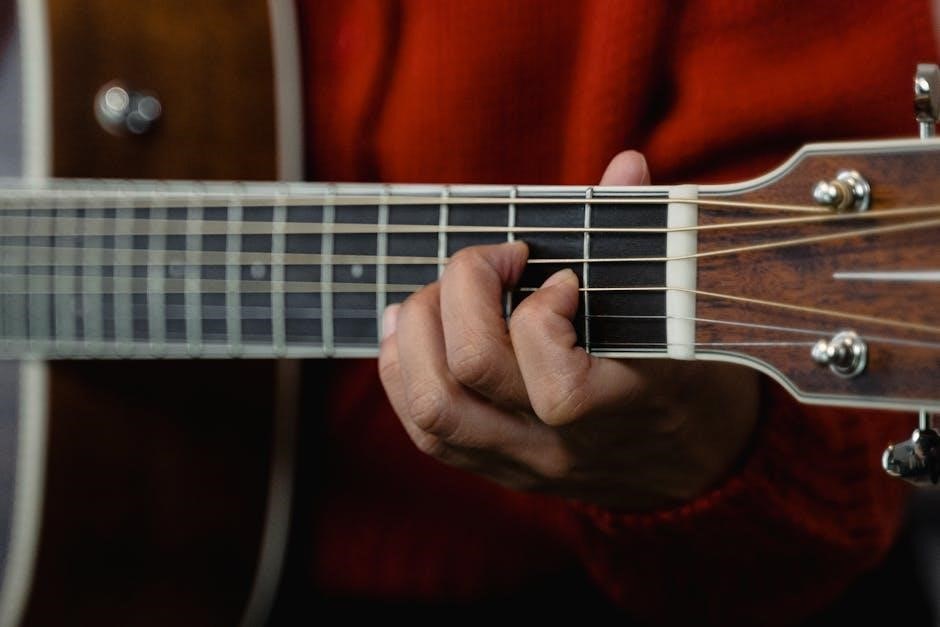Chord progressions are the backbone of music, guiding melodies and harmonies. For guitarists, understanding these sequences is crucial for songwriting and playing across genres. PDF resources offer detailed chord charts, essential for learning and mastering these progressions, making them invaluable for both beginners and experienced musicians.
1.1 What Are Chord Progressions?
Chord progressions are sequences of chords played in a specific order, forming the harmonic foundation of music. They provide structure, emotional depth, and a framework for melodies and lyrics. For guitarists, chord progressions are essential for songwriting, improvisation, and accompaniment. A progression can be simple, like the I-IV-V in a major key, or complex, incorporating suspended, minor, or seventh chords. They are fundamental for creating mood and atmosphere in music, guiding listeners through emotional journeys. Whether in rock, pop, jazz, or classical genres, chord progressions are the backbone of musical composition and performance.
- Chords are groups of notes played together.
- Progressions are sequences of these chords.
- They create harmonic movement and resolution.
1.2 Importance of Chord Progressions in Guitar Playing
Chord progressions are vital for guitarists as they form the harmonic structure of songs, enabling effective songwriting and performance. They provide a framework for melodies and lyrics, allowing guitarists to create emotionally resonant music. Mastery of chord progressions enhances versatility, enabling players to adapt to various genres and styles. They also serve as a foundation for improvisation, making them essential for both beginners and advanced musicians. By understanding and practicing chord progressions, guitarists can improve their overall musicality and creativity, ensuring their playing is both expressive and engaging.
- Enhance songwriting and composition skills.
- Provide structure for melodies and lyrics.
- Facilitate improvisation and creativity.
1.3 Brief History of Chord Progressions in Music
Chord progressions have evolved significantly over centuries, from classical music to modern genres. The Roman numeral system, introduced in the 18th century, laid the groundwork for understanding chord functions. In the 1950s, rock music popularized the I-IV-V progression, becoming a cornerstone of modern songwriting. Jazz and blues further expanded the use of extended chords and modal interchange. Today, chord progressions remain a fundamental element of music, with resources like PDF guides and books providing detailed insights for guitarists. This historical evolution continues to inspire new musical creations, making chord progressions timeless and versatile.
- Rooted in classical harmony and theory.
- Popularized in rock, jazz, and blues.
- Continuously evolving with modern genres.

Basic Chord Progressions for Beginners
Mastering simple chord progressions is essential for guitarists. Start with common chords like G, C, D, and E, which form the foundation of many songs. Practice switching between chords smoothly to build finger strength and rhythm. These progressions are versatile and can be applied to various genres, making them a great starting point for developing your skills. Regular practice will help you play confidently and explore more complex progressions as you progress.
Key tips: Focus on chord transitions and timing to create a solid rhythm section.
2.1 Common Chord Progressions for Acoustic Guitar
Acoustic guitar chord progressions often use simple, versatile chords like G, C, D, Em, and Am. A common progression is G-C-D, which works for many folk and pop songs. Another popular choice is Am-F-G, creating a melancholic yet catchy melody. These progressions are ideal for beginners due to their simplicity and widespread use in popular music. Starting with these will help build a strong foundation for more complex compositions. Focus on smooth chord transitions and consistent strumming patterns to enhance your sound. Experimenting with these progressions can also inspire your own songwriting journey.
Key tip: Practice these progressions daily to improve finger strength and rhythm;
2.2 Simple Chord Progressions for Songwriting
Simple chord progressions are the backbone of effective songwriting. Using chords like G, Em, C, and D allows for emotional depth while maintaining simplicity. A common progression is G ⎼ Em ⸺ C ⎼ D, which creates a memorable and singable melody. These progressions are versatile and can fit multiple genres. Start by choosing a key that suits your vocal range or guitar playing style. Experiment with chord substitutions and variations to add uniqueness to your songs. Remember, simplicity often leads to the most impactful compositions. Use chord charts to explore different keys and styles, helping you craft meaningful and engaging music.
Key tip: Focus on emotional connection over complexity when writing.
2.3 Four-Chord Progressions: I, V, vi, IV
The I, V, vi, IV progression is one of the most popular chord sequences in music. It creates a sense of resolution and emotional depth. For example, in the key of C Major, this would be C ⸺ G ⎼ Am ⸺ F. This progression is widely used in pop, rock, and acoustic music due to its versatility. The tonic (I) establishes the key, the dominant (V) builds tension, the minor (vi) adds emotion, and the subdominant (IV) provides resolution. This pattern is easy to learn and adapt, making it a great starting point for songwriters. It’s also a foundation for countless hit songs.
Key tip: Practice switching between these chords smoothly to master the progression.

Advanced Chord Progressions
Explore complex harmonies and techniques like modal interchange, extended chords, and altered dominants. These progressions add depth, tension, and color to your music, perfect for jazz, fusion, or progressive rock. Mastering these requires a strong foundation in basic principles.
3.1 Jazz Chord Progressions for Guitar
Jazz chord progressions often feature extended chords like 7ths, 9ths, and 11ths, creating rich harmonic textures. The ii-V-I progression is central, with altered dominants adding tension. Guitarists can use drop-2 and drop-3 voicings for smooth transitions. Incorporating modal interchange and chromaticism expands possibilities. For example, a typical progression might be Dm9 ⎼ G7alt ⎼ Cmaj9. Practicing these requires precision and a deep understanding of jazz harmony. Explore standards like “Blue Bossa” or “Summertime” for practical application. These progressions elevate your playing and open doors to complex, emotionally engaging music.
3.2 Rock and Blues Chord Progressions
Rock and blues chord progressions rely heavily on the 12-bar blues structure, often using I, IV, and V chords. The 12-bar blues is a staple, with variations like quick changes adding diversity. Seventh chords (e.g., E7, A7) and power chords are common, creating a gritty, energetic sound. Blues progressions frequently incorporate pentatonic scales for solos. Classic examples include “Sweet Home Chicago” or “Pride and Joy.” These progressions emphasize rhythm and emotional intensity, making them foundational for rock and blues guitar playing. Mastering these will enhance your ability to play authentically in these genres.
3.3 Modal Interchange in Chord Progressions
Modal interchange involves borrowing chords from parallel keys or modes to create rich, expansive sounds. This technique allows guitarist to blend chords from the major and minor versions of a key, adding emotional depth. For example, in a major key, borrowing from the parallel minor can introduce tension and color. Similarly, in a minor key, using chords from the major mode can evoke contrasting moods. This approach is widely used in jazz and fusion music but can enhance any genre. By exploring modal interchange, guitarists can craft intricate, nuanced chord progressions that stand out, offering endless creative possibilities for composition and improvisation.

Chord Progressions in Different Genres
Chord progressions vary significantly across musical genres, reflecting distinct harmonic and structural preferences. Each genre employs specific chord patterns to evoke unique emotional and cultural resonance, shaping its identity and appeal to listeners.
4.1 Rock Chord Progressions
Rock music often relies on powerful, driving chord progressions that create energy and tension. Commonly used chords include power chords (e.g., E5, A5), major chords (e.g., E, A), and minor chords (e.g., Em, Am). Progressions like E5-B5-A5 or E-B-A-E are staples in rock, providing a strong, repetitive structure. Rock also incorporates techniques like palm muting and syncopation to enhance rhythm. Many iconic rock songs, such as “Sweet Child O’ Mine” or “Back in Black,” use simple yet memorable progressions. These patterns are versatile, allowing for improvisation and solos while maintaining a solid harmonic foundation.
4.2 Pop Chord Progressions
Pop music thrives on catchy, memorable chord progressions that appeal to a broad audience. Commonly used progressions include the I-V-vi-IV pattern (e.g., C-G-Am-F in the key of C), which is both simple and emotionally resonant. These progressions often blend major and minor chords to create a balance of happiness and melancholy. Many pop hits, like “Can’t Stop the Feeling” or “We Are Young,” rely on these structures. Variations may include adding seventh chords (e.g., Cmaj7, G7) or using modal interchange to add depth. Pop chord progressions are designed to be singable and radio-friendly, making them a cornerstone of modern songwriting.
4.3 Classical and Folk Chord Progressions
Classical and folk music often utilize timeless chord progressions that evoke emotional depth and storytelling. Classical music frequently employs minor and major scales, with progressions like i-iv-v-i (A minor, D minor, E, A minor) common in sonatas. Folk music, meanwhile, relies on simple, memorable structures, often in major keys, such as I-IV-V-I (C-F-G-C). These progressions are adaptable to guitar, with fingerstyle techniques enhancing their expressive qualities. Many classical and folk pieces use suspended or modal chords (e.g., Csus2, Am7) to add complexity. These progressions are well-documented in guitar PDF guides, making them accessible for study and performance.

Using Chord Progressions in Songwriting
Chord progressions are essential for songwriting, providing structure and emotional depth. They inspire creativity and guide the harmonic flow of a song, as detailed in guitar PDF guides.
5.1 How to Write Your Own Chord Progressions
Writing chord progressions involves experimenting with sequences of chords that evoke emotion and structure. Start with a key, using chords like I, IV, and V for simplicity. Consider common progressions as templates but add unique variations. Use chord functions (tonic, dominant, subdominant) to create harmonic movement. Experiment with seventh chords or modal interchange for depth. Practice transitioning smoothly between chords to enhance playability. Record your ideas and refine them over time. Drawing inspiration from guitar PDF guides can provide foundational knowledge and spark creativity for crafting original progressions tailored to your musical style.
5.2 Using Chord Charts for Songwriting
Chord charts are invaluable tools for songwriting, providing a clear visual layout of guitar chords and their finger placements. They allow songwriters to quickly identify chord shapes and experiment with progressions. Many chord charts are available in PDF guides, which often include diagrams for common chords in various keys. By referencing these charts, writers can explore different chord voicings and inversions to add depth to their music. Organizing favorite chords into custom charts can also streamline the songwriting process, enabling faster access to inspiration and reducing creative blocks. This approach fosters efficiency and enhances the overall musical composition.
5.3 Tips for Creating Emotionally Resonant Progressions
Creating emotionally resonant chord progressions involves understanding how chords convey feelings. Start by experimenting with minor and major chords, as they evoke different moods—minors for sadness and majors for happiness. Dynamics and tempo can amplify emotional impact; slower tempos often intensify feelings, while faster ones create energy. Modulation to a different key can add surprise and depth. Incorporate suspended or diminished chords for tension, resolving them to create catharsis. Listen to iconic songs and analyze their progressions to inspire your own. Practice with emotional intent, as feeling drives connection in music. This approach will help craft progressions that deeply resonate with listeners.

Resources for Guitar Chord Progressions
Discover comprehensive guides, online tools, and apps to master chord progressions. Explore PDFs, software, and mobile apps designed to enhance your learning and practice experience effectively.
6.1 Recommended PDF Guides for Chord Progressions
Explore a variety of downloadable PDF guides that provide detailed chord progressions for guitar. These resources often include charts, theory, and practical exercises to help you improve. Many PDFs focus on specific genres, such as rock, jazz, or blues, offering tailored progressions for each style. Beginners can benefit from step-by-step guides, while advanced players can explore complex harmony and modulation techniques. Some popular PDFs include comprehensive libraries of chords, scales, and progressions, making them invaluable for songwriting or jamming sessions. Whether you’re a novice or seasoned guitarist, these guides offer structured learning and inspiration to expand your musical repertoire.
6.2 Online Tools for Generating Chord Progressions
Utilize online tools to create and explore chord progressions for guitar. Websites like Guitar Tricks and Songsterr offer extensive libraries of chords and progressions, allowing you to visualize and play along. Tools such as Chordify enable you to extract chords from songs, while others like Hookpad or Chord Progression Generator provide customizable templates. These platforms often include features like key selection, genre-specific options, and the ability to transpose progressions. They are invaluable for both learning and creating, offering a dynamic way to experiment with harmonies and discover new sounds to enhance your guitar playing and songwriting skills.
6.3 Apps for Practicing Chord Progressions
Enhance your practice with apps designed for chord progression mastery. Fender Play and Yousician offer interactive lessons and exercises tailored to guitarists. Guitar Tricks provides a comprehensive library of lessons and progressions. Apps like Chord! and Chord Progression Builder allow you to explore and create custom progressions. These tools often include features such as customizable tempo, real-time feedback, and song libraries. They are ideal for mastering chord transitions, building finger strength, and developing a strong harmonic foundation. By incorporating these apps into your routine, you can streamline your learning process and improve your guitar playing effectively.

Practicing and Mastering Chord Progressions
Consistent practice is essential for mastering chord progressions. Focus on building muscle memory, improving transitions, and playing smoothly. Regular dedication enhances technique and musical expression.
7.1 Exercises for Improving Chord Transition
Improving chord transitions requires focused practice. Start with slow, deliberate movements between chords, emphasizing clean finger placement. Use a metronome to gradually increase speed. Focus on problem areas, such as switching between chords that feel awkward. Isolation exercises, like switching between two chords repeatedly, can build muscle memory. Practice chord shapes in different positions on the neck to enhance familiarity. Incorporate scales or arpeggios to strengthen finger dexterity. Record yourself to identify and refine weak spots. Regular practice, even for short sessions, will lead to smoother, more confident transitions. This foundational work is key to mastering chord progressions effectively.
7.2 How to Memorize Chord Progressions
Memorizing chord progressions involves repetition, practice, and mental association. Start by practicing slowly, focusing on clean transitions. Break down complex progressions into smaller sections and gradually combine them. Visualize the chord shapes on the fretboard while playing to reinforce muscle memory. Use emotional or lyrical connections to remember specific sequences. Record and replay your practice to identify patterns. Consistency is key—dedicate short daily sessions to review and refine. Over time, familiar progressions will become second nature, allowing you to focus on expression and creativity during performance. This methodical approach ensures long-term retention and mastery of chord progressions.
7.3 Incorporating Scales into Chord Progressions
Incorporating scales into chord progressions enhances melodic and harmonic depth. Start by identifying the key of your progression, as scales are directly tied to chord functions. For example, a G major chord pairs with the G major scale. Practice switching between chords and their corresponding scales to create smooth transitions. Use scale fragments or modes to add variety and emotion. Experiment with improvising over chord changes using scales to develop solos or melodies. Listening to songs and identifying how scales are integrated into progressions can inspire your own playing and composition. This fusion of scales and chords elevates musical expression and complexity.

Chord Progressions in Popular Songs
Exploring chord progressions in popular songs reveals timeless patterns and emotional resonance. Analyzing hits like Yesterday or Hotel California shows how chords create memorable melodies and harmonies. This insight helps guitarists understand the craft behind iconic music.
8.1 Analyzing Famous Songs’ Chord Progressions
Analyzing famous songs’ chord progressions offers insights into musical structure and emotional impact. Songs like Hey Jude and Stairway to Heaven use timeless chord sequences that resonate deeply. These progressions often rely on common patterns, such as the I-V-vi-IV progression, but are elevated by unique twists. By studying these, guitarists can identify how chord choices create mood and narrative. This analysis also reveals how artists modify or combine progressions to craft something original. Understanding these techniques helps players and songwriters incorporate similar strategies into their own music, making their compositions more engaging and memorable.
8.2 Learning from Classic Rock Songs
Classic rock songs are a treasure trove of iconic chord progressions that every guitarist should study. Tracks like Sweet Child O’ Mine and Satisfaction showcase memorable riffs and chord sequences. These songs often use simple, powerful progressions like the I-IV-V or blues-based patterns. Analyzing these helps guitarists understand how to create catchy, enduring music. By breaking down these progressions, players can learn how to adapt them into their own playing style. Classic rock also highlights the importance of rhythm and chord voicings, offering valuable lessons for crafting dynamic and engaging music.
8.3 Modern Songs with Iconic Chord Progressions
Modern songs often feature chord progressions that blend simplicity with emotional depth. Tracks like Shape of You by Ed Sheeran and Stay with Me by Sam Smith use variations of the I-V-vi-IV progression, creating memorable melodies. Songs like Someone Like You by Adele rely on minor chords to evoke sadness. These progressions, while rooted in tradition, are adapted to contemporary styles. They demonstrate how chord progressions can evolve while retaining their emotional impact. Studying these songs helps guitarists understand modern songwriting techniques and how to craft progressions that resonate with listeners.

The Role of Chord Progressions in Music Theory
Chord progressions form the harmonic foundation of music, establishing key centers and emotional depth. They dictate harmonic movement and resolution, fundamental to music theory and composition.
9.1 Understanding Chord Functions
Chord functions—tonic, dominant, subdominant, and pre-dominant—define a chord’s role within a key. The tonic (I) establishes the key center, while the dominant (V) creates tension seeking resolution. The subdominant (IV) adds contrast, and pre-dominant chords (ii, iii, vi) lead into the dominant. These functions guide harmonic movement, ensuring logical progression and emotional depth in music. For guitarists, understanding chord functions enhances composition, improvisation, and the ability to adapt progressions across genres. Mastery of these roles is essential for crafting coherent, emotionally resonant music.
9.2 The Roman Numeral System in Chord Progressions
The Roman Numeral System assigns numbers to chords based on their scale degrees within a key. Uppercase numerals denote major chords, while lowercase indicate minor chords. For example, in the key of C, I represents C major, IV is F major, and V is G major. This system simplifies understanding chord relationships and functions, such as tonic (I), subdominant (IV), and dominant (V). It aids in creating versatile progressions applicable to any key, enhancing musical composition and analysis. Mastery of this system is crucial for effective songwriting and improvisation.
9.3 Key Signatures and Their Impact on Progressions
Key signatures define the tonality and guide the selection of chords and notes in a progression. They determine the placement of sharps (#) or flats (♭) in a key, influencing chord choices. For instance, the key of G major includes one sharp (F#), shaping its chord progressions. Common key signatures for guitar include G, C, D, E, and A, as they align with the instrument’s tuning. Understanding key signatures helps create harmonically coherent progressions, ensuring chords and melodies align emotionally and structurally. This knowledge is essential for crafting resonant and genre-appropriate music.

Experimenting with Chord Progressions
Experimenting with chord progressions involves exploring new sounds and techniques to create unique music. Guitarists can alter chords, incorporate scales, and test unconventional key changes to enhance creativity.
10.1 Adding Seventh Chords to Progressions
Adding seventh chords to progressions enriches the harmonic texture, creating deeper emotional resonance. Major, minor, and dominant seventh chords offer distinct moods. For example, a C Major 7 chord (C-E-G-B) adds brightness, while a C Minor 7 (C-Eb-G-Bb) brings melancholy. Dominant 7ths, like C7 (C-E-G-Bb), add tension. Guitarists can substitute basic chords with their seventh counterparts or use them sparingly for contrast. Experimenting with these chords in progressions can elevate simple sequences into sophisticated, jazz-inspired sounds. A chord progressions for guitar PDF often includes seventh chord charts for easy reference, aiding in seamless integration.
10.2 Using Suspended and Altered Chords
Suspended and altered chords add unique color and tension to progressions. Suspended chords (e.g., Csus2, Csus4) replace the third with a fourth or second, creating an open, unresolved feel. Altered chords modify thirds, fifths, or sevenths, such as C7(b9) or C7(#9), adding harmonic complexity. These chords are ideal for creating emotional intensity or modernizing traditional progressions. Guitarists can use them sparingly to add surprise or depth. A chord progressions for guitar PDF often provides diagrams for these chords, making it easier to incorporate them into compositions or covers for a distinctive sound.
10.3 Incorporating Modal Exchange Chords
Modal exchange chords expand harmonic possibilities by borrowing chords from parallel modes or scales. For guitarists, this means incorporating chords like Dmaj7(b5) or E7(#9) into progressions for added color. These chords create tension and release, enhancing emotional impact. A chord progressions for guitar PDF often highlights these techniques, offering practical examples to apply them in various keys. Experimenting with modal exchange can elevate simple progressions into sophisticated compositions, making it a powerful tool for songwriters and improvisers seeking unique harmonic textures.
Mastering chord progressions is a journey that combines music theory, creativity, and practice. This guide has provided essential insights to enhance your guitar playing and songwriting skills.
11.1 Recap of Key Points
11.2 Encouragement to Keep Practicing
Mastering chord progressions is a journey that requires patience, dedication, and consistent practice. While it may feel challenging at times, remember that every chord you learn and every progression you practice brings you closer to unlocking your musical potential. Celebrate small victories, like smoothly transitioning between chords or writing your first original progression. Use resources like chord charts, apps, and online tools to stay motivated. Surround yourself with music that inspires you, and don’t hesitate to learn from others. Keep pushing forward—your hard work will pay off, and the joy of creating music will be your reward.
11.3 Final Thoughts on Chord Progressions
Chord progressions are the heart of music, offering endless possibilities for creativity and expression on the guitar. Whether you’re playing classic rock, jazz, or pop, mastering chord progressions unlocks the door to crafting meaningful songs and connecting with listeners. The journey of learning and experimenting with chords is deeply rewarding, allowing you to explore emotions and styles. With dedication and curiosity, you’ll continually discover new ways to enhance your playing. Remember, chord progressions are not just a technical skill—they’re a powerful tool for telling stories through music. Embrace the process, and let your guitar sing.

No Responses